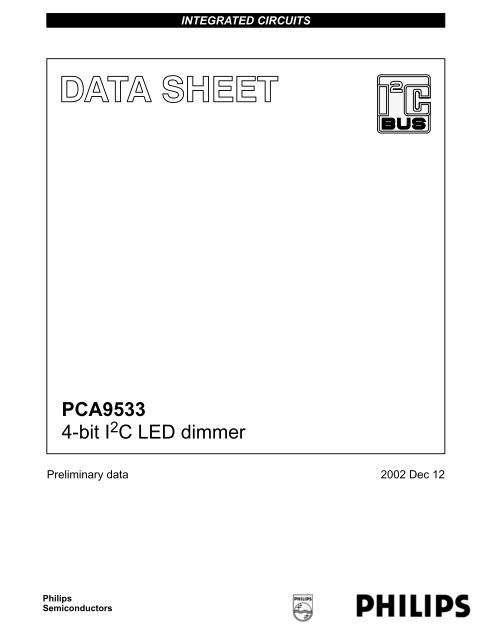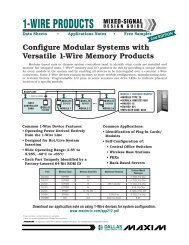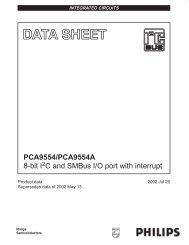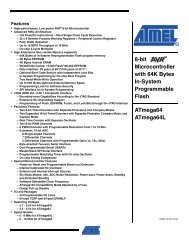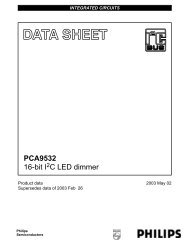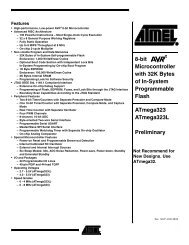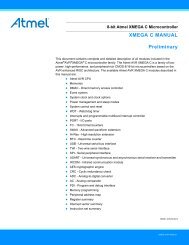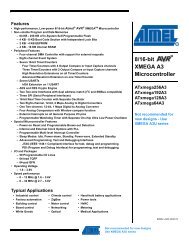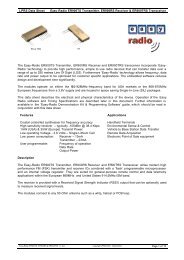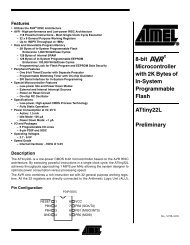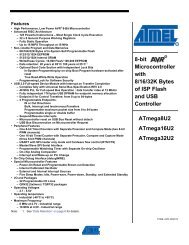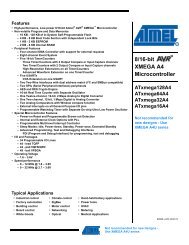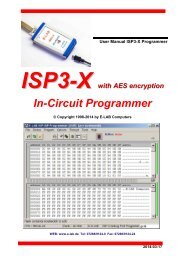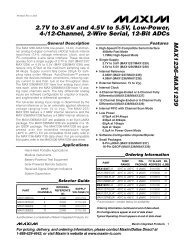PCA9533 4-bit I C LED dimmer - E-LAB Computers
PCA9533 4-bit I C LED dimmer - E-LAB Computers
PCA9533 4-bit I C LED dimmer - E-LAB Computers
Create successful ePaper yourself
Turn your PDF publications into a flip-book with our unique Google optimized e-Paper software.
Philips Semiconductors4-<strong>bit</strong> I 2 C <strong>LED</strong> <strong>dimmer</strong>Preliminary data<strong>PCA9533</strong>AcknowledgeThe number of data bytes transferred between the start and the stop conditions from transmitter to receiver is not limited. Each byte of eight <strong>bit</strong>sis followed by one acknowledge <strong>bit</strong>. The acknowledge <strong>bit</strong> is a HIGH level put on the bus by the transmitter whereas the master generates anextra acknowledge related clock pulse.A slave receiver which is addressed must generate an acknowledge after the reception of each byte. Also a master must generate anacknowledge after the reception of each byte that has been clocked out of the slave transmitter. The device that acknowledges has to pull downthe SDA line during the acknowledge clock pulse, so that the SDA line is stable LOW during the HIGH period of the acknowledge related clockpulse, set-up and hold times must be taken into account.A master receiver must signal an end of data to the transmitter by not generating an acknowledge on the last byte that has been clocked out ofthe slave. In this event, the transmitter must leave the data line HIGH to enable the master to generate a stop condition.DATA OUTPUTBY TRANSMITTERDATA OUTPUTBY RECEIVERnot acknowledgeSCL FROMMASTERSSTART conditionacknowledge1 2 8 9Figure 9. Acknowledgement on the I 2 C-busclock pulse foracknowledgementSW003682002 Dec 12 6
Philips Semiconductors4-<strong>bit</strong> I 2 C <strong>LED</strong> <strong>dimmer</strong>Preliminary data<strong>PCA9533</strong>APPLICATION DATA5 V3.3 VV DDSDASCLSDASCL<strong>LED</strong>0<strong>LED</strong>1<strong>LED</strong>2<strong>LED</strong>3I 2 C/SMBus MASTERV SS<strong>PCA9533</strong>SW02047Figure 13. Typical applicationMinimizing I DD when the I/O is used to control <strong>LED</strong>sWhen the I/Os are used to control <strong>LED</strong>s, they are normally connected to V DD through a resistor as shown in Figure 13. Since the <strong>LED</strong> acts as adiode, when the <strong>LED</strong> is off the I/O V IN is about 1.2 V less than V DD . The supply current , I DD , increases as V IN becomes lower than V DD and isspecified as ∆I DD in the DC characteristics table.Designs needing to minimize current consumption, such as battery power applications, should consider maintaining the I/O pins greater than orequal to V DD when the <strong>LED</strong> is off. Figure 14 shows a high value resistor in parallel with the <strong>LED</strong>. Figure 15 shows V DD less than the <strong>LED</strong> supplyvoltage by at least 1.2 V. Both of these methods maintain the I/O V IN at or above V DD and prevents additional supply current consumption whenthe <strong>LED</strong> is off.V DD3.3 V5 VV DD<strong>LED</strong>100 kV DD<strong>LED</strong><strong>LED</strong>x<strong>LED</strong>xSW02086Figure 14. High value resistor in parallel with the <strong>LED</strong>Figure 15. Device supplied by a lower voltageSW020872002 Dec 12 8
Philips SemiconductorsPreliminary data4-<strong>bit</strong> I 2 C <strong>LED</strong> <strong>dimmer</strong><strong>PCA9533</strong>Programming exampleThe following example will show how to set <strong>LED</strong>0 and <strong>LED</strong>1 off. Itwill set <strong>LED</strong>2 to blink at 1 Hz, 50% duty cycle. <strong>LED</strong>3 will be set to bedimmed at 25% of their maximum brightness (duty cycle = 25%).<strong>PCA9533</strong>-1 is used in this example.Table 1.I 2 C-busStart<strong>PCA9533</strong> addressPSC0 subaddress + auto-incrementSet prescaler PSC0 to achieve a period of 1 second:Blink period 1 PSC0 1152PSC0 = 151Set PWM0 duty cycle to 50%:PWM0256 0.5SC4h11h97h80hPWM0 = 128Set prescaler PWM1 to dim at maximum frequency00hBlink period maximumPSC1 = 0Set PWM1 output duty cycle to 25%:PWM1256 0.25PWM1 = 64Set <strong>LED</strong>0 on, <strong>LED</strong>1 off, <strong>LED</strong>2 set to blink at PSC0,PWM0, <strong>LED</strong>3 set to blink at PCS1, PWM1Stop40hE1hP2002 Dec 12 9
Philips Semiconductors4-<strong>bit</strong> I 2 C <strong>LED</strong> <strong>dimmer</strong>Preliminary data<strong>PCA9533</strong>ABSOLUTE MAXIMUM RATINGSIn accordance with the Absolute Maximum Rating System (IEC 134)SYMBOL PARAMETER CONDITIONS MIN MAX UNITV DD Supply voltage -0.5 6.0 VV I/O DC voltage on an I/O V SS - 0.5 5.5 VI I/O DC output current on an I/O — +25 mAI SS Supply current — 100 mAP tot Total power dissipation — 400 mWT stg Storage temperature range -65 +150 °CT amb Operating ambient temperature -40 +85 °CHANDLINGInputs and outputs are protected against electrostatic discharge in normal handling. However, to be totally safe, it is desirable to takeprecautions appropriate to handling MOS devices. Advice can be found in Data Handbook IC24 under ”Handling MOS devices”.DC CHARACTERISTICSV DD = 2.3 to 5.5 V; V SS = 0 V; T amb = -40 to +85 °C; unless otherwise specified. TYP at 3.3 V and 25 °C.SYMBOL PARAMETER CONDITIONS MIN TYP MAX UNITSuppliesV DD Supply voltage 2.3 — 5.5 VI DD Supply currentOperating mode; V DD = 5.5 V; no load;V I = V DD or V SS ; f SCL = 100 kHz— 350 500 µAI stb∆I DDStandby currentAdditional standby currentStandby mode; V DD = 5.5 V; no load;V I = V DD or V SS ; f SCL = 0 kHzStandby mode; V DD = 5.5 V; Every<strong>LED</strong> I/O at V IN = 4.3 V; f SCL = 0 kHz— 1.9 3.0 µA— — µAV POR Power-on reset voltage No load; V I = V DD or V SS — 1.7 2.2 VInput SCL; input/output SDAI/OsV IL LOW level input voltage -0.5 — 0.3 V DD VV IH HIGH level input voltage 0.7 V DD — 5.5 VI OL LOW level output current V OL = 0.4V 3 — — mAI L Leakage current V I = V DD = V SS -1 — +1 µAC I Input capacitance V I = V SS — 3.7 5 pFV IL LOW level input voltage -0.5 — 0.8 VV IH HIGH level input voltage 2.0 — 5.5 VI OLLOW level output currentV OL = 0.4 V; V DD = 2.3 V; Note 1 9 — — mAV OL = 0.4 V; V DD = 3.0 V; Note 1 12 — — mAV OL = 0.4 V; V DD = 5.0 V; Note 1 15 — — mAV OL = 0.7 V; V DD = 2.3 V; Note 1 15 — — mAV OL = 0.7 V; V DD = 3.0 V; Note 1 20 — — mAV OL = 0.7 V; V DD = 5.0 V; Note 1 25 — — mAI L Input leakage current V DD = 3.6 V; V I = 0 or V DD -1 — 1 µAC IO Input/output capacitance — 2.1 5 pFNOTES:1. The maximum sink current for any single I/O must be externally limited to 25 mA.2002 Dec 12 10
Philips Semiconductors4-<strong>bit</strong> I 2 C <strong>LED</strong> <strong>dimmer</strong>Preliminary data<strong>PCA9533</strong>AC SPECIFICATIONSSTANDARD MODE I 2 CBUSFAST MODEI 2 C BUSSYMBOLPARAMETERUNITSMIN MAX MIN MAXf SCL Operating frequency 0 100 0 400 kHzt BUF Bus free time between STOP and START conditions 4.7 — 1.3 — µst HD;STA Hold time after (repeated) START condition 4.0 — 0.6 — µst SU;STA Repeated START condition setup time 4.7 — 0.6 — µst SU;STO Setup time for STOP condition 4.0 — 0.6 — µst HD;DAT Data in hold time 0 — 0 — nst VD;ACK Valid time for ACK condition 2 — 600 — 600 nst VD;DAT (L) Data out valid time 3 — 600 — 600 nst VD;DAT (H) Data out valid time 3 — 1500 — 600 nst SU;DAT Data setup time 250 — 100 — nst LOW Clock LOW period 4.7 — 1.3 — µst HIGH Clock HIGH period 4.0 — 0.6 — µst F Clock/Data fall time — 300 20 + 0.1 C b1 300 nst R Clock/Data rise time — 1000 20 + 0.1 C 1 b 300 nst SP Pulse width of spikes that must be suppressed by the — 50 — 50 nsinput filtersPort Timingt PV Output data valid — 200 — 200 nst PS Input data setup time 100 — 100 — nst PH Input data hold time 1 — 1 — µsNOTES:1. C b = total capacitance of one bus line in pF.2. t VD;ACK = time for Acknowledgement signal from SCL low to SDA (out) low.3. t VD;DAT = minimum time for SDA data out to be valid following SCL low.2002 Dec 12 11
Philips Semiconductors4-<strong>bit</strong> I 2 C <strong>LED</strong> <strong>dimmer</strong>Preliminary data<strong>PCA9533</strong>+20%MAX+10%0%AVG-10%PERCENTVARIATION-20%MIN-30%-40-40%0 +25 +70 +85TEMPERATURE(°C)SW01085Figure 16. Typical frequency variation over process at V DD = 2.3 V to 3.0 V+20%MAX+10%0%AVG-10%PERCENTVARIATION-20%MIN-30%-40-40%0 +25 +70 +85TEMPERATURE(°C)SW01086Figure 17. Typical frequency variation over process at V DD = 3.0 V to 5.5 V2002 Dec 12 12
Philips Semiconductors4-<strong>bit</strong> I 2 C <strong>LED</strong> <strong>dimmer</strong>Preliminary data<strong>PCA9533</strong>SDAt LOWt Rt Ft HD;STAt SPPSt HD;DATtBUFt HD;STAPSCLt SU;STAt HIGH t SU;DAT Srt SU;STOSU00645Figure 18. Definition of timing2002 Dec 12 13
Philips Semiconductors4-<strong>bit</strong> I 2 C <strong>LED</strong> <strong>dimmer</strong>Preliminary data<strong>PCA9533</strong>SO8: plastic small outline package; 8 leads; body width 3.9 mm SOT96-12002 Dec 12 14
Philips Semiconductors4-<strong>bit</strong> I 2 C <strong>LED</strong> <strong>dimmer</strong>Preliminary data<strong>PCA9533</strong>TSSOP8: plastic thin shrink small outline package; 8 leads; body width 3 mm SOT505-12002 Dec 12 15
Philips Semiconductors4-<strong>bit</strong> I 2 C <strong>LED</strong> <strong>dimmer</strong>Preliminary data<strong>PCA9533</strong>VSSOP8: plastic very thin shrink small outline package; body width 2.3 mm SOT765-12002 Dec 12 16
Philips Semiconductors4-<strong>bit</strong> I 2 C <strong>LED</strong> <strong>dimmer</strong>Preliminary data<strong>PCA9533</strong>Purchase of Philips I 2 C components conveys a license under the Philips’ I 2 C patentto use the components in the I 2 C system provided the system conforms to theI 2 C specifications defined by Philips. This specification can be ordered using thecode 9398 393 40011.Data sheet statusLevelData sheet status [1]Productstatus [2] [3]DefinitionsIObjective dataDevelopmentThis data sheet contains data from the objective specification for product development.Philips Semiconductors reserves the right to change the specification in any manner without notice.IIPreliminary dataQualificationThis data sheet contains data from the preliminary specification. Supplementary data will be publishedat a later date. Philips Semiconductors reserves the right to change the specification without notice, inorder to improve the design and supply the best possible product.IIIProduct dataProductionThis data sheet contains data from the product specification. Philips Semiconductors reserves theright to make changes at any time in order to improve the design, manufacturing and supply. Relevantchanges will be communicated via a Customer Product/Process Change Notification (CPCN).[1] Please consult the most recently issued data sheet before initiating or completing a design.[2] The product status of the device(s) described in this data sheet may have changed since this data sheet was published. The latest information is available on the Internet at URLhttp://www.semiconductors.philips.com.[3] For data sheets describing multiple type numbers, the highest-level product status determines the data sheet status.DefinitionsShort-form specification — The data in a short-form specification is extracted from a full data sheet with the same type number and title. For detailed information seethe relevant data sheet or data handbook.Limiting values definition — Limiting values given are in accordance with the Absolute Maximum Rating System (IEC 60134). Stress above one or more of the limitingvalues may cause permanent damage to the device. These are stress ratings only and operation of the device at these or at any other conditions above those givenin the Characteristics sections of the specification is not implied. Exposure to limiting values for extended periods may affect device reliability.Application information — Applications that are described herein for any of these products are for illustrative purposes only. Philips Semiconductors make norepresentation or warranty that such applications will be suitable for the specified use without further testing or modification.DisclaimersLife support — These products are not designed for use in life support appliances, devices, or systems where malfunction of these products can reasonably beexpected to result in personal injury. Philips Semiconductors customers using or selling these products for use in such applications do so at their own risk and agreeto fully indemnify Philips Semiconductors for any damages resulting from such application.Right to make changes — Philips Semiconductors reserves the right to make changes in the products—including circuits, standard cells, and/or software—describedor contained herein in order to improve design and/or performance. When the product is in full production (status ‘Production’), relevant changes will be communicatedvia a Customer Product/Process Change Notification (CPCN). Philips Semiconductors assumes no responsibility or liability for the use of any of these products, conveysno license or title under any patent, copyright, or mask work right to these products, and makes no representations or warranties that these products are free from patent,copyright, or mask work right infringement, unless otherwise specified.Contact informationFor additional information please visithttp://www.semiconductors.philips.com. Fax: +31 40 27 24825For sales offices addresses send e-mail to:sales.addresses@www.semiconductors.philips.com.Document order number:© Koninklijke Philips Electronics N.V. 2002All rights reserved. Printed in U.S.A.Date of release: 12-02PhilipsSemiconductors2002 Dec 12 17


